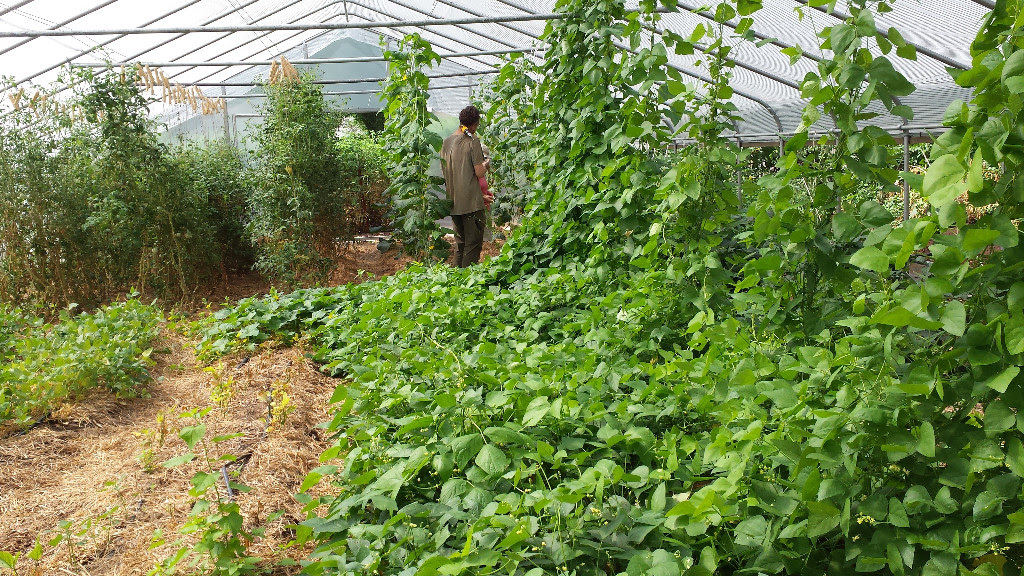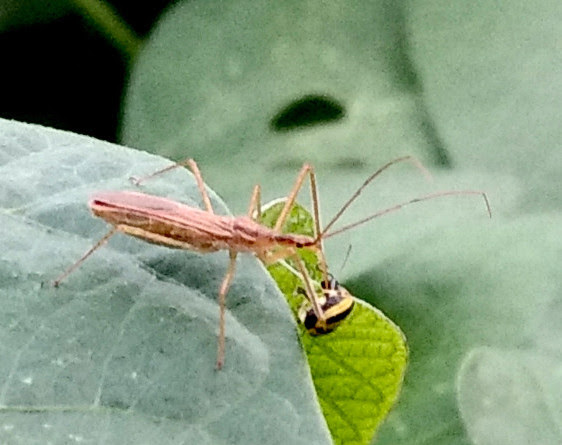Garden School: Three Cheers
for Lactic Acid Bacteria!
Bacteria!
Saturday, August 12
11 am to noon
CommonWealth Urban Farms
3310 N. Olie, OKC
$5, payable on site
Learn about one of the components of the Korean Natural Farming method of cultivating indigenous microorganism to maintain soil fertility with no external inputs. David will show how he makes lactic acid bacteria (LAB) and uses it for faster composting, odor prevention, soil fertility and foliar sprays. David will also provide free samples of LAB to participants!
Instructor: David Braden, co-founder of CommonWealth Urban Farms
(PLEASE NOTE DATE CHANGE FROM ORIGINAL SCHEDULE)
Saturday, August 19: Plan & Plant Your Fall Garden
with Lia Woods, co-founder and farm manager of CommonWealth
Check out other upcoming Garden Schools on our website.
You did it!
THANK YOU!!!
 Thank you, thank you, thank you to all our supporters. The GoFundMe campaign is over the top: $4,270 of our $3,900 goal. With your help we were able to recover from the hoop house meltdown and we now have abundant growth and are beginning to get production in the hoop house again. We couldn’t have made such a big recovery without you all. It is SO heartening to know that so many generous friends in our community care about growing food in the city! (Details of the campaign are here.)
Thank you, thank you, thank you to all our supporters. The GoFundMe campaign is over the top: $4,270 of our $3,900 goal. With your help we were able to recover from the hoop house meltdown and we now have abundant growth and are beginning to get production in the hoop house again. We couldn’t have made such a big recovery without you all. It is SO heartening to know that so many generous friends in our community care about growing food in the city! (Details of the campaign are here.)Veggie Spotlight: Why I Like Cucumbers
 A few years ago, on a hot afternoon in mid-May, I was planting cucumber seedlings with a friend. She taught me to smell the root balls as I was planting; the roots smell just like cucumbers! Even a quick whiff of that crisp, invigorating scent made me feel a few degrees cooler.And that is the magic of cucumbers. Hidden inside that plain green envelope of waxy skin is a marvelously refreshing vegetable with endless appeal. Cucumber sandwiches, homemade refrigerator pickles, or chilled cucumber avocado soup, anyone? How about cucumber-lime sorbet? Or this Super Simple Cucumber Salad? I never tire of panzanella salad, made with summer’s bounty of tomatoes, cucumbers, basil and arugula.
A few years ago, on a hot afternoon in mid-May, I was planting cucumber seedlings with a friend. She taught me to smell the root balls as I was planting; the roots smell just like cucumbers! Even a quick whiff of that crisp, invigorating scent made me feel a few degrees cooler.And that is the magic of cucumbers. Hidden inside that plain green envelope of waxy skin is a marvelously refreshing vegetable with endless appeal. Cucumber sandwiches, homemade refrigerator pickles, or chilled cucumber avocado soup, anyone? How about cucumber-lime sorbet? Or this Super Simple Cucumber Salad? I never tire of panzanella salad, made with summer’s bounty of tomatoes, cucumbers, basil and arugula.
This is our first summer with our beautiful new hoop house. We put a shadecloth over it, so it’s cooler inside, and we’re growing tomatoes and cucumbers vertically on trellis strings that hang down from the trusses. Inside that protected environment, cucumbers are supposed to grow like gangbusters, producing long, beautiful fruit—and, ha!—they are!
Outside, we succession plant cucumbers through the summer to extend the harvest, allowing new plants to take over when older plants succumb to bugs or disease. Wire fencing provides an easy and inexpensive trellis.
 Cucumbers come in more sizes and colors then one would ever dream by just walking down the grocery aisle. Lemon cucumbers are small and round, with pale yellow skin. Poona kheera is an unusual variety from India with caramel brown skin. I’ve found Diva to be a reliable producer, even in our hot summers, and have heard other southern growers say the same. Armenian cucumbers are actually a type of melon, but they look and taste like cucumbers, and are exceptionally productive. Any way you slice it, cucumbers are a winner in the summer garden.—Lia
Cucumbers come in more sizes and colors then one would ever dream by just walking down the grocery aisle. Lemon cucumbers are small and round, with pale yellow skin. Poona kheera is an unusual variety from India with caramel brown skin. I’ve found Diva to be a reliable producer, even in our hot summers, and have heard other southern growers say the same. Armenian cucumbers are actually a type of melon, but they look and taste like cucumbers, and are exceptionally productive. Any way you slice it, cucumbers are a winner in the summer garden.—Lia
Meet our Apprentices: Karelia Rodriguez

Karelia Rodriguez is a chef who wanted to learn how to grow food. In June, when she began her CommonWealth apprenticeship, she had two tomato plants at home. “I didn’t know how to identify suckers and trim them; how to get soil ready for planting; how to take care of a plant; how to harvest. I didn’t even know how to water!” (All CommonWealth apprentices learn how to water plants the way rain waters plants.)
“Now I know the difference between growing tomatoes outside and in a hoop house. It’s interesting to learn the different methods.”
One of her assignments during her apprenticeship was to make a plan for a fall garden in the 4×12 raised bed she has at home. “Lia had us plan the garden, then she advised us about our plan—considering the size of the plants when they’re mature, etc. I’m learning a lot. And Lia is so patient explaining things to us.”
Karelia, or “Kar” as she’s also called, plans to volunteer when her apprenticeship ends. “I love CommonWealth. It’s a great community. I love how the neighbors are involved; how everyone is open and welcoming to anyone coming to learn.”
At home, Karelia’s two tomato plants died this summer. “They were too far gone before I learned how to take care of them.” Working as a chef at several restaurants in the past, she now has ideas about doing her own thing next. You can be sure home-grown tomatoes will be on the menu!—Pat
Consider Becoming a CommonWealth Apprentice
Our third apprenticeship season will begin September 5. Deadline for application is August 25, 2017.
Our learning method is hands-on. For each new skill and task, we’ll show you how to do it, supervise you while you learn, then give you a chance to demonstrate your skill and eventually teach it others. We want apprentices to learn new skills, and learn them well!
To find out more and apply, click here.
Bug Spotlight: The Assassin
 The Assassin bug—cool name right? Yeah, cool name. The assassin bug is a general term for a rather large family of true bugs in the Reduviidae family. As the name suggests, they are predatory insects. You might think of them as your own personal garden ninjas or knights, as they are highly beneficial to growers.There are roughly 150 species in North America alone. Of these species, the Wheel bug is the largest, sizing in at approximately 1¼ inches long. Great care should be employed with the handling of assassin bugs, Wheels in particular—or perhaps avoidance entirely, as they will bite if handled carelessly. The bite is known to be intensely painful.
The Assassin bug—cool name right? Yeah, cool name. The assassin bug is a general term for a rather large family of true bugs in the Reduviidae family. As the name suggests, they are predatory insects. You might think of them as your own personal garden ninjas or knights, as they are highly beneficial to growers.There are roughly 150 species in North America alone. Of these species, the Wheel bug is the largest, sizing in at approximately 1¼ inches long. Great care should be employed with the handling of assassin bugs, Wheels in particular—or perhaps avoidance entirely, as they will bite if handled carelessly. The bite is known to be intensely painful.
 Assassin bugs prey on a great variety of garden pests including flies, mosquitoes, beetles and caterpillars. They use a long, protruding and piercing mouthpart known as a beak. Assassin bugs catch and puncture their prey, injecting salivary secretions that then dissolve the prey’s internal tissues. I believe the proper scientific term is: gooification. Yes, that sounds right.
Assassin bugs prey on a great variety of garden pests including flies, mosquitoes, beetles and caterpillars. They use a long, protruding and piercing mouthpart known as a beak. Assassin bugs catch and puncture their prey, injecting salivary secretions that then dissolve the prey’s internal tissues. I believe the proper scientific term is: gooification. Yes, that sounds right.
Young insects are called nymphs. They are often brightly colored and quite cute, in my personal opinion. In what can only be described as truly fascinating behavior, assassin bugs have been known to disguise and camouflage themselves with dust, dirt and the dead carcass remains of their victims, effectively confusing its would-be-predators. Rad. So the next time you happen upon one of these little hunters in your garden be sure to take a moment to appreciate their beauty and give thanks for all the slaying they do on your behalf.—Christopher
